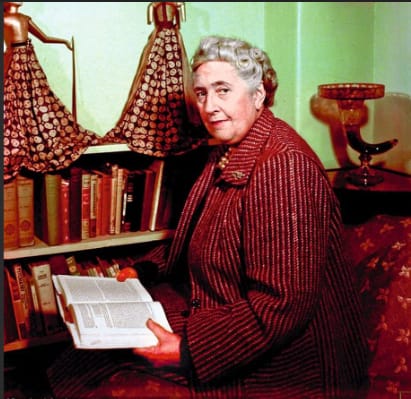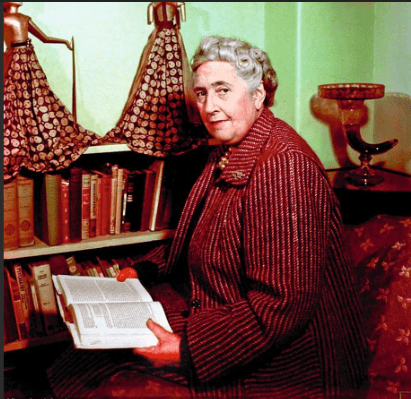
A Reckless Practice with Real-Life Consequences I’ve Witnessed Firsthand
Trigger warning: This article contains vivid descriptions of panic attacks, hyperventilation, and physical distress. Please read with caution.
How Agatha Christie Perpetuated a Dangerous and Misguided ‘Cure’ for Mental Illness
I was 15 when I was diagnosed with generalized anxiety disorder (GAD) and panic disorder. I had already been battling clinical depression for a year by that time, but adding two more invisible illnesses to the mix felt like stepping onto a battlefield where the enemy was lurking inside my own mind.
At that age, I had no real understanding of what mental illness was. Words like “anxiety” and “panic” were just abstract concepts, something I had only vaguely heard about. But the reality hit me like a freight train. I was suddenly thrust into a world where my mind and body were at constant war — and I had no idea how to fight back.
The First Time I Felt My World Collapse
The first time I had a panic attack, I thought I was having a heart attack.
It was late one evening. I remember the sharp, stabbing pain in my chest, the way my heart pounded so hard it felt like it was trying to escape my ribcage. My fingers tingled, my vision blurred, and my head throbbed with an unbearable intensity. I couldn’t catch my breath — my lungs felt like they were collapsing, as if the air was being sucked out of the room.
This has to be a heart attack.
That’s what I thought as I sat there, gasping for air, clutching my chest. But I was wrong.
Later that night, I learned about my family history of panic attacks. Apparently, I wasn’t the first in my family to feel like the world was caving in. I was just the latest in a long line of people who had silently endured these terrifying experiences.
The Nightmare of Hyperventilation
As if panic attacks weren’t enough, a few months later, I experienced hyperventilation for the first time.
According to MaryAnn De Pietro, CRT, a longtime practicing certified respiratory therapist, hyperventilation occurs when your breathing becomes too rapid, causing you to exhale more carbon dioxide than you inhale oxygen. This imbalance triggers a cascade of frightening physical symptoms:
- Lightheadedness
- Tingling or numbness in the fingers
- A pounding heart
- A splitting headache
- A feeling that no amount of air is enough
I had all of the above.
During that episode, I was gasping, heaving, desperately trying to pull in air that felt out of reach. But the harder I tried to breathe, the worse it got. It felt like I was suffocating in plain sight. And because this episode was triggered by a panic attack — which, according to Johns Hopkins Medicine, is a common cause of hyperventilation — the symptoms only intensified.
My body was in full crisis mode, but the real battle was happening inside my head.
Mental Health Awareness Was Barely a Whisper
This was 2014.
Back then, awareness of mental health — especially among teenagers — was a fraction of what it is today. Conversations about anxiety, depression, and panic disorders were often met with misunderstanding or dismissal. Mental illness was something people whispered about, not something openly discussed or validated.
I didn’t know where to turn for help. And worse, I wasn’t even sure if what I was experiencing deserved help.
Agatha Christie and the Misguided ‘Cure’
This brings me to the reason I’m sharing my story.
During those difficult years, I found solace in books. I devoured anything I could get my hands on, often finding comfort in the pages of classic literature. One of my favorites was Agatha Christie, the queen of mystery and intrigue. But nestled within the pages of her stories was a practice that, in hindsight, fills me with unease.
Christie, in her novels, often depicted characters being slapped or physically shocked out of hysteria or panic. The idea was that a sudden, violent jolt — a slap across the face, a dousing of cold water — would somehow reset the person’s mind and bring them back to reality.
It was a dangerous and ignorant concept, one that perpetuated the harmful belief that mental illness could be “cured” through brute force or humiliation.
Violence Is Not a Cure
To anyone who has ever experienced a panic attack or hyperventilation, the notion that physical violence could “snap you out of it” is not only absurd — it’s reckless.
Panic attacks don’t respond to force. Hyperventilation doesn’t magically stop because someone raises their voice or delivers a slap. These conditions stem from deep-rooted physiological and psychological responses that require understanding, patience, and care — not aggression.
Yet, Christie’s portrayal of this method ingrained a harmful narrative in the public consciousness. It reinforced the idea that people experiencing panic or hysteria were somehow being irrational or dramatic, and that a forceful interruption was the best way to bring them back to their senses.
Real-Life Consequences of Misconceptions
I’ve witnessed the consequences of this misguided belief firsthand.
I’ve seen people try to calm someone in the midst of a panic attack by shaking them or yelling at them to “just breathe.” I’ve heard stories of individuals who, in moments of crisis, were met with physical restraint or aggression instead of compassion.
These actions don’t help. They escalate. They traumatize. They leave lasting scars that go far beyond the initial panic.
I know because I’ve been there.
A Better Way to Respond
If you’ve ever been with someone experiencing a panic attack, hyperventilation, or an anxiety crisis, here’s what you should do instead:
- Stay Calm: Your calm energy can help ground the person. Speak in a soothing, reassuring voice.
- Remind Them to Breathe Slowly: Guide them to take slow, deep breaths. A simple “Breathe with me” can help regulate their breathing.
- Ground Them with Their Senses: Encourage them to engage their senses by describing what they see, hear, and feel. This can help bring them back to the present moment.
- Don’t Touch Without Consent: Physical contact can be grounding, but only if the person is comfortable with it. Ask before touching.
- Offer Reassurance: Remind them that the panic will pass and that they are safe.
Breaking the Cycle of Misinformation
We’ve come a long way since 2014. Mental health awareness has grown, and more people are recognizing that anxiety, panic, and depression are not just “phases” or “weaknesses.” But the damage caused by outdated, harmful portrayals of mental illness — like those found in Christie’s works — lingers.
It’s time we rewrite the narrative.
Mental health crises don’t need violence. They need compassion. They need understanding. And they need a society that’s willing to break free from the myths of the past and embrace the truth of what it means to struggle with mental illness.
We owe it to those who are still fighting these invisible battles to get it right.
Final Thoughts: Let’s Do Better
Agatha Christie may have been a master storyteller, but her depiction of “curing” mental illness through violence is a reminder that even beloved classics can perpetuate harmful myths.
We know better now. And when we know better, we must do better.
For every 15-year-old kid out there, gasping for breath in the middle of the night, wondering if anyone will ever understand — we owe them a world where they are met with empathy, not aggression.
Because no one should have to fight this battle alone.



